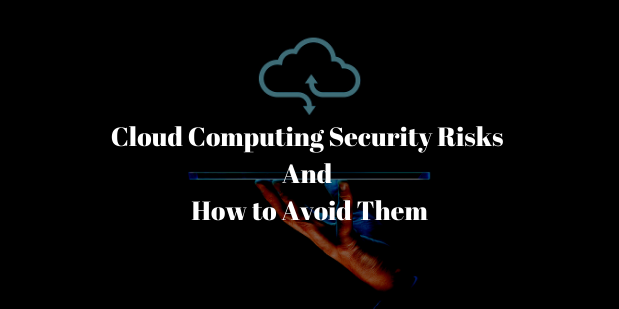Cloud Computing Security Risks in 2020 & How to Avoid Them

Cloud Technology has evolved from time to time and eases human lives in many ways. But due to its high usage, it has turned cybersecurity on its head. In this advancement era the availability, scope of data and interconnectedness has made it extremely vulnerable from many threats. Companies have taken a lot of time to understand this as a possible threat and now have started taking this issue seriously.
The transition to the cloud has brought new security challenges and since cloud computing services are available online, means that every right credentials can access it. One of the main problems that come with assessing security is the need to understand the consequences of letting things happen within your system. So today, we will look at six cloud security threats, and also explain how to minimize risks and avoid them.
What are the main Cloud Computing Security Issues?
Poor Access Management
Access management is a common cloud computing security risk. It is easy to access and that is why hackers find it very easy to target it so much. LinkedIn experienced a massive breach of user data in 2016 and that includes account credentials and the numbers are approximately equal to 164 million. There are few reasons why this might have happened.
1.Insufficient crisis management
2.Ineffective information campaign
3.The cunningness of the hackers
Because of this attack, some hackers were able to hijack the accounts. And there are many such examples at Google & Facebook of such attacks which has already caused a lot of slumber at big organizations. However, there are a few ways to handle this issue.
Multi Factor Authentication – It’s a well known thing nowadays as companies are using to make the user’s account more secure as it layers to system access. Along with a regular password user gets a disposable key on a private device. If the account is locked down, the user is sent a notification in case of an attempted break in.
Distinct layout for Access Management – It is the availability of information for different types of users. For instance, the marketing team department doesn’t need to have access to application development protocols & vice versa.
Data Breach & Data Leak – the Main Cloud Security Concerns
The data breach can really affect things and usually happens because the company must have neglected some of the cloud security flaws, and this caused a natural consequence.
What is Data Breach?
It is an accident in which the information is accessed and extracted without authorization. This event usually results in a data leak that means that data is located where it is not supposed to be. The confidential information of the people on the internet is sold on the black market or held for ransom. The extent of this breach depends on the crisis management skills of the company.
How Data Breaches Occur?
The information that is stored in the cloud storage is under multiple levels to get its access. However, it is available from various devices and accounts with cryptographic keys. So, a hacker can get into the data once they know someone who has access to it. Let us see how a data breach operation can go down.
->First hacker starts studying the company’s structure for weaknesses on both people and technology they use.
-> Once they find the victim, the hacker finds different ways to approach the targeted individual. This operation includes identifying the user’s social media account, interest, and possible flaws of the individual.
-> After all this information the victim is tricked into giving access to the company’s network and there are two ways of doing it.
-> First one is to install malware into the victim’s computer.
-> Second one includes social engineering, by gaining trust and persuading someone to give out their login credentials.
How to Avoid Data Breaches from Happening?
A cloud security system must have a multi-layered approach that checks and covers the whole extent of user activity every step of the way.
Multi-Factor Authentication – In this step the user must present more than evidence of his identity and access credentials. For instance, typing a password and then receiving a notification on a mobile phone with a randomly generated single use string of numbers active for a short period. This has become one of the cloud security standards nowadays.
Data at Rest Encryption – Data at rest is a type of data that is stored in the system but not active in different devices. Usually this process includes logs, databases, datasets, etc.
Perimeter Firewall – It is between a private and public network that controls in and out traffic in the system.
Data Loss
If you find a data breach very threatening than data loss is an even worse cloud security threat to the people and the companies if not taken seriously. Data Loss is very hard to predict and very hard to handle so let us have a look at the most common reasons for data loss:
Data Alteration – If the information is changed in some way, & cannot be reverted to the previous state and this issue may happen with dynamic databases.
Unreliable Storage Medium Storage – When data gets lost due to problems on the cloud provider’s side.
Data Deletion – If the critical information is deleted or erased from the system with no backups to restore. Basically it happens because of human error, messy database structure or malicious intent.
Loss of Access – The information is still in the system but unavailable due to lack of encryption keys and other credentials.
How to Prevent Data Loss of Happening?
Frequent data backups can be a very effective way to avoid any kind of data loss. You can schedule backups for every month or every week and what kind of data is eligible for backups and what is not. There are a few loss prevention softwares that can help you with this automated process.
Geodiversity – With geodiversity is when the physical location of the cloud servers in data centers is scattered & not dependent on a particular spot. It also help with the aftermath of natural disasters and power outages.
Insecure API
API stands for Application User Interface is the primary instrument used to operate the system within the cloud infrastructure. This process includes internal use by the company’s employee and external use by consumers via products like mobile or web applications. The external side is critical due to all data transmission enabling the service and in return providing all sorts of analytics. The availability of API makes it a significant cloud security risk. In addition to that, API is involved in gathering data from edge computing devices.
Authentication and Encryption are two significant factors that keep the system regulated & safe from harm. And sometimes the configuration of the API is not upto requirements and contains many flaws which can be used to compromise its integrity. Here we have a few common problems:
-> Lack of Access Monitoring(Happens due to Negligence)
-> Anonymous Access (Getting access without Authentication)
-> Clear-Text Authentication (When you can see input on the screen)
-> Reusable tokens & Passwords (Used in Brute Force Attacks)
The most recent example of insecure API was the Cambridge Analytica scandal. Facebook API has deep access to user data and Cambridge Analytica used it for selling to other companies.
How to Avoid Problems with API?
-> General system security audits
-> Using penetration testing that emulates an external attack targeting specific API endpoints. It is used to break the security and gain access to the company’s integral information.
-> Multi-factor authentication to avoid unauthorized access.
-> Transport layer security encryption for data transmission
Misconfigured Cloud Storage
Misconfigured cloud storage is a continuation of an insecure API cloud security threat. Mostly security issues happen due to an oversight & subsequent superficial audits. Cloud misconfiguration is a setting for cloud servers and it makes it vulnerable to breaches. So, we have configured most common types of misconfiguration.
Mismatched Access Management– When an unauthorized person unintentionally gets access to sensitive data.
Default cloud Security Settings – The settings of the server with standard access management and also the availability of data.
Mangled Data Access – When important/confidential data is left out in the open and requires no authorization.
To avoid it, you need to double check cloud security configurations when you step up a particular cloud server. It gets passed by for the sake of more important things like updating stuff into storage without second thoughts regarding its safety.
You should also use specialized tools while checking security configurations. You can also use third party tools like Dome9 and Cloudsploit to check the state of security configurations on a schedule and identify possible problems before it is too late.
DoS Attack – Denial of Service Attack
The best thing about clouds is that this system can carry a considerable workload. But it doesn’t mean it can handle everything seamlessly. It can anytime overload and stop working and that can be a significant cloud security threat.
Many times the goal is not to get into the system but to make it unusable for customers and that is called a denial of service attack. Usually it’s main purpose of denial of service attack is to prevent users from accessing applications or disrupting its workflow.
it usually messes with the service level agreement between the company and the customer. It can mess with the credibility of the company. There are two major types of DoS attacks.
->Brute force attack from multiple sources
-> More elaborate attacks targeted at specific system exploits
How to Avoid DoS Attacks?
Firewall Traffic Type Inspection Features – To check the source & destination of incoming traffic, and also assess its possible nature by IDS tools.
Up to Date Intrusion Detection System – It allows you to identify anomalous traffic and provide an early warning based on credentials & behavioral factors.
Blocking of the IP addresses – If you want to keep the situation under control then you can use it to block unknown IP addresses.
Source Rate Limiting – One of the critical goals to DoS is to consume bandwidth.
Other Security Risks & Threats
Cloud & On-Premise Threats & Risks
-> Credentials are stolen
-> Increases Complexity Strains IT Staff
-> Insufficient Due Diligence Increases Cybersecurity Risk
-> CSP Supply Chain when Compromised
-> Vendor Lock In
Cloud Unique Threats & Risks
-> Separation Among Multiple Tenants Fails
-> Reduced Visibility & Control from Customers
-> Data deletion is incomplete and people can take use of it
Yes, it’s true that cloud technology has changed the way of doing business for companies. As it brings a whole new set of security risks, it has given many ways to hackers to create numerous cloud security issues. The shift to cloud technology gave companies much needed scalability and flexibility to remain competitive and innovative in the ever changing business environment. So we suggest that following the latest cloud security is the best way to protect your company from reputational and monetary losses.
Read More: VerveLogic
# How Much Does It Cost to Make an App
# How to Hire iOS App Developer
# Tinder Alternatives: Best Dating Apps Like Tinder 2020
# How to Outsource Mobile App Development
# Big Data and Machine Learning
# Functional vs Non-Functional Requirements: Main Differences & Examples




